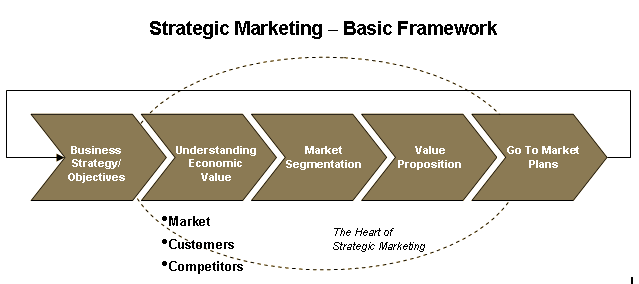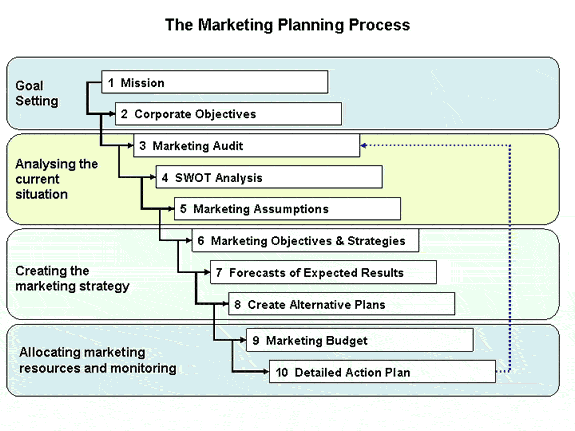Definition of strategy and marketing strategy. Importance of strategy for marketers
Marketing strategy is a set of well-defined plans that are formulated, implemented and continuously evaluated and altered with the main aim of enabling commercial organizations to concentrate on using limited resources to tap into the best opportunities, to maximize on sales revenues and hence achieve organizational goals. Marketing strategies are major tools by which organizations can differentiate themselves and place themselves at a competitive advantage within the dynamic business environment (Hawkins, Roger, Coney and Koch 2007, 112).
Marketing strategies enable companies to strategically segment their markets, position their products and target specific consumers. Business organizations that put in place perfect marketing strategies are more likely to understand their target market, consumers and competitors and respond appropriately to them as their behavioural patterns change due to their dynamic nature (Roger and Peterson 2009, 88).

The Coca-Cola Company is one such example of a company that has incorporated marketing strategies in their business model to maintain its place as one of the most respected soft drink companies in the world. Marketing strategies usually require companies to strategically Segment, Position and Target specific markets by manipulating the 4p’s of marketing as the environment changes rapidly (Wilson and Gilligan 2005, 54-60). The Coca-Cola Company has used its numerous product lines of carbonated soda, water, natural juice, and energy drinks to target various consumers. By knowing that firms can either be leaders, challengers, or followers Coca-Cola has successfully conducted highly efficient SWOT analysis before venturing into various markets (Scott 2011, par. 8).
The result of this SWOT analysis has enabled the company clearly understand how the political, economic, social, demographic and legal environments and how it would impact their aggressive business model hence, enabling the Coca-Cola company successfully implement marketing strategies with the most appropriate pricing strategy, promotion strategy, distribution and product strategies (Scott 2011, par. 10). Consequently, if the company did not follow the path of strategic marketing then the level of commercial success that the company experiences now would have been much lower.
Apple is also another commercial organization that has decided to adopt the platform of technological superiority to market its products to the world. Apple founder and current C.E.O, Steve Jobs, has put in place a superior marketing strategy that has enabled the company to attain a market leadership status upon manufacturers of computer tablets through the recent release of the iPad, furthermore, the company has offered a stiff competition to Smartphone and Android phone manufactures by strategically developing the iPhone and targeting consumers who demand technologically advanced mobile phones (Lambert 2008, 62-75).
Apple spends millions of dollars in research and development of technologically superior products and sells them at a premium price after embarking on very vigorous marketing promotion campaigns (Apple Inc 2011). Thus the superior product development strategy within Apple has assisted the company to design superior products successfully using a leapfrog strategy which places their products technologically ahead of all competitors (Michael and Kaye. 2005, 132).
By the time other competitors start imitating their technology and product strategy apple would have been able to move forward and invest in much better technology beating their competitors again. Sony has been able to use the same strategy to manufacture and sell their latest Bravia Engine Technology that is used to manufacture the highest quality of LCD screens and 3D TV sets (Porter 1990, 188).
If companies did not effectively plan their marketing function it would have then been very hard for commercial enterprises to successfully achieve their goals and objectives. Marketing strategy enables companies to plan against uncertainties and risk and therefore be at a better competitive advantage (Roger and Peterson 2009, 36-38). Organizations which do not engage in aggressive marketing strategy and planning find it very hard to effectively respond to the actions and happenings of other competitors, it is thus very important for organizational executives to carefully incorporate strategic marketing in the daily operations all marketing departments (Wheelen and Hunger 2002, 314).
Some ways that marketers can be better strategists and use strategy to achieve better outcomes
Marketers are always faced with the burden of creating strategies that are of high quality. A good strategy can only be said to be good only if it assists a corporate entity to achieve all its goals and objective, and therefore when experts analyze the performance of a strategy they may often use the mission and vision of an organization to justify whether if the strategy has failed or succeeded (Camillus 1986 104-113). Therefore, marketers and strategic planners may embark on the marketing planning process to ensure that they develop strategies that are considered of high quality and most likely to succeed in the rapidly changing environment (Hiles 2010, 98).

Marketers who wish to make highly appreciated and effective strategies must enter into a complete research process and gather all the relevant information that will validate reasons behind their strategic options. Knowing this then marketer will aim to understand the market, consumers and competitors by simply using SWOT analysis and environmental scanning techniques so that all the relevant data can be gathered to support their reasons for whatever strategic path they choose (Sinkovics and Ghauri 2009, 13-24). When The Coca-Cola Company decided to withdraw the classical Coca-Cola soft drink and replace it with a new formula on 23-04-1985 this move was considered as a disaster and infamy to marketing (The CocaCola Company 2010).
This is because the level of outrage and a public outburst that followed that action was so much that the sales of Coca-Cola decreased drastically. The reason behind this public outburst was clear evidence that those behind the strategic marketing and planning of this change were wrong because they had not carried out a complete environmental scan and SWOT analysis of the market needs, taste and preferences, the competitors. It only took the Coca-Cola Company close to 80 days for that strategic decision to be reversed by the board of Coca-Cola (The CocaCola Company 2010). Because the company’s goal-setting phase and the situation analysis phase was wrongly carried out, then the strategy-setting process failed and it did not matter whether The Coca-Cola Company put more resources behind the strategy to monitor it.
Hence, if marketers wish to make better strategies it is a must that they know the full set of weaknesses and strengths that the business will be faced with while pursuing the various strategies. Additionally, each portion of the target market and segment should be analyzed to understand the particular demographic dimensions that may have an impact on the short-run and long-run implementation of their strategies (Trott 2008, 106). After all relevant facts are gathered it is also vital to put in place back up plans and ensure that mechanisms of monitoring and controlling the strategy are also put in place.
Although the recession of 2007-2010 hit the American economy hard, McDonald’s strategy to gain market share within the Coffee industry was not adversely affected simply because the company conducted a feasibility study, SWOT analysis and environmental scans that enabled the company implement a cost leadership strategy (Bennet 2006, 42-45). Thus when Starbucks lost its grounds and lost market share McDonald’s was able to stabilize its business model during the recession, because their strategy formulation process was as a result of a good market research and planning process that enabled the company to align its goals with the goals of the market, consumers and also at the same time respond to the actions of competitors.
Reference list
Apple Inc. 2011. Web.
Bennet, P. 2006. Marketing Management and Strategy. 4th edn. New York, NY: Prentice Hall.
Camillus, J. 1986. Strategic planning and management control: systems for survival and Success. Lexington, KY: Lexington Books.
Hawkins, D., B. Roger, K. Coney, and E. Koch. 2007. Consumer behavior: Building marketing strategy. Boston: McGraw-Hill/Irwin.
Hiles, A. 2010. The Definitive Handbook of Business Continuity Management. New Jersey: John Wiley and Sons.
Lambert, D. 2008. Supply chain management: processes, partnerships, performance. New York: Supply Chain Management Inst.
Michael, A. and J. Kaye. 2005. Simplified strategic planning: a no-nonsense guide for busy people who want results fast. Worcester, MA: Chandler House Press.
Porter, M. 1990. The competitive Advantage of Nations. Northampton, MA: The Free Press.
Roger, K. and R. Peterson. 2009. Strategic marketing problems: Cases and comments. 12th edn. New York: Prentice Hall.
Scott, D. 2011. The new rules of viral marketing; how word-of-mouse spreads your ideas for free. Web.
Sinkovics, R. and P. Ghauri. 2009. New Challenges to International Marketing. London: Emerald Group Publishing.
The CocaCola Company. 2010. Coke Lore. Web.
Trott. P. 2008. Innovation Management and New Product Development. 4th edn. London: Pearson.
Wheelen, T. and D. Hunger 2002. Strategic management and business policy. New Jersey: Prentice Hall.
Wilson, R., and C. Gilligan. 2005. Strategic marketing management: planning, implementation and control. New York: Butterworth-Heinemann.
